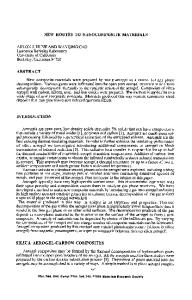Molecular Routes to Tin Oxides
- PDF / 571,277 Bytes
- 12 Pages / 420.48 x 639 pts Page_size
- 64 Downloads / 438 Views
MOLECULAR ROUTES TO TIN OXIDES
T.A. WARK*, E.A. GULLIVER*, L.C. JONES*, M.J. HAMPDEN-SMITH*, A.L. RHEINGOLD** AND J.C. HUFFMAN*** *Department of Chemistry and Center for Micro-Engineered Ceramics, University of New Mexico, Albuquerque, NM 87131.
"**Department of Chemistry, University of Delaware, Newark, DE
19716. ***Molecular Structure Center, Indiana University, Bloomington, IN 47405.
ABSTRACT A general route to low temperature synthesis of ternary metal tin oxides with controlled stoichiometries from single component molecular metal alkoxide precursors is described. The solid state and solution structures of homoleptic tin(IV) alkoxide compounds have been investigated to establish criteria for the determination of their solution structure. Tin alkoxide compounds suitable for metathesis reactions have been synthesized and used to prepare the mixed metal alkoxide compounds [ZnSn(OEt)6 ] and [((COD)Rh) 2 Sn(OEt)6] (where Et = ethyl and COD = 1,5-cyclooctadiene). Hydrolysis of [ZnSn(OEt)6] at neutral pH results in the formation of a high surface area, mainly amorphous hydrous oxide powder which forms Zn2SnO 4 and SnO2 on heating to 600 0 C and ZnSnO3 on heating to 1000 0C.Thermolysis of [((COD)Rh }2 Sn(OEt) 6 ] results in formation of rhodium and tin(IV) oxide (cassiterite phase).
INTRODUCTION
The preparation of metal oxide ceramics is currently an area of intense scientific and industrial interest. In particular, complex metal oxides such as superconducting phases [1] and ferroelectric materials [2] have received much attention. Significant advances in this area are likely to arise from new synthetic strategies [3], new processing techniques [4] and a better understanding of condensation phenomena [5]. The work described here is aimed at developing a systematic synthetic approach for preparing multicomponent metal oxides and investigating condensation processes. For many years, metal alkoxide compounds have been used as precursors for the formation of metal oxides by sol-gel type hydrolytic condensation [3,6]. The potential advantages of this method over other methods include lower processing temperatures, better homogeneity, controlled stoichiometry and flexibility of processing to form dense monoliths, thin films or high surface area powders, for example. A number of different approaches have been taken to synthesize mixed metal oxides. In most studies, solutions containing mixtures of different metal alkoxide compounds have been hydrolytically condensed [7], while there are Mat. Res. Soc. Symp. Proc. Vol. 180. (1990 Materials Research Society
62
relatively few studies in which discrete, molecular mixed metal alkoxide species have been hydrolyzed [8]. A potential advantage of using a single component molecular precursor is that stoichiometry should be controlled on the molecular level. As part of our studies to prepare mixed metal oxides with controlled stoichiometries, we are developing a systematic approach centered on tin(IV) alkoxide chemistry as shown below, nMOR + Sn(OR) 4 - ------> MnSn(OR)4+n
(1
Data Loading...











